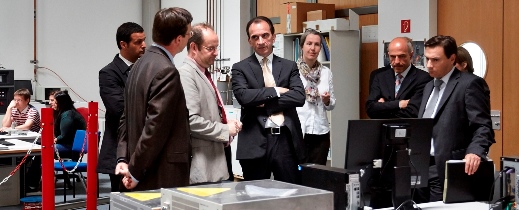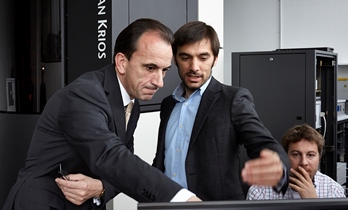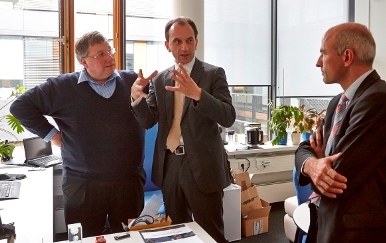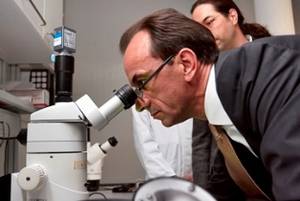News Archive
Hessian Minister for Federal Affairs visits BMRZ and BMLS
Minister Michael Boddenberg visited the Center for Biomolecular Magnetic Resonance (BMRZ) and the Buchmann Institute of Molecular Life Sciences (BMLS) on Riedberg campus in Frankfurt/Main on 10 June 2013 as part of the 'Research Awareness Weeks'. Here some highlights of his tour:
Center for Biomolecular Magnetic Resonance (BMRZ):

Clemens Glaubitz (2nd from left) and Harald Schwalbe (3rd from left) explain to the Minister (4th from left) the NMR spectrometers of the BMRZ, which is the largest research infrastructure facility for high-end nuclear and electron magnetic resonance spectroscopy in Europe. BMRZ is equipped with 10 high-field liquid-state NMR spectrometers (up to 950 MHz), two high-field solid-state NMR spectrometers (850 and 600 MHz) as well as four EPR spectrometers as well as a liquid-state and a solid-state NMR DNP setup. The Center serves the scientific community as one of the European Large Scale Facilities for Magnetic Resonance Spectroscopy (Bio-NMR).
Buchmann Institute of Molecular Life Sciences (BMLS):
 Achilleas Frangakis explains to Minister Michael Boddenberg a sample viewed under the Titan Krios electron microscope in the Buchmann Institute for Molecular Life Sciences. The research of the Frangakis group focuses on revealing the macromolecular organization of living cells by means of cryo-electron tomography. Cryo-electron tomography is the only technique that allows to obtain molecular resolution images of intact cells in a quasi-native environment. Their tomograms contain an imposing amount of information as they are essentially a three-dimensional map of the cellular proteome and depict the whole network of macromolecular interactions. Information mining algorithms exploit structural data from various techniques, identify distinct macromolecules and computationally fit atomic resolution structures in the cellular tomograms, thereby bridging the resolution gap. More ….
Achilleas Frangakis explains to Minister Michael Boddenberg a sample viewed under the Titan Krios electron microscope in the Buchmann Institute for Molecular Life Sciences. The research of the Frangakis group focuses on revealing the macromolecular organization of living cells by means of cryo-electron tomography. Cryo-electron tomography is the only technique that allows to obtain molecular resolution images of intact cells in a quasi-native environment. Their tomograms contain an imposing amount of information as they are essentially a three-dimensional map of the cellular proteome and depict the whole network of macromolecular interactions. Information mining algorithms exploit structural data from various techniques, identify distinct macromolecules and computationally fit atomic resolution structures in the cellular tomograms, thereby bridging the resolution gap. More ….

Minister Michael Boddenberg (centre) in conversation with Ernst Stelzer (l.) and CEF Speaker Volker Dötsch (r.) about three-dimensional imaging, which the group of Ernst Stelzer developed to observe cells in a much more natural environment than the flat surfaces on which cells are usually used in microscopy. In the laboratory the Minister was shown the light sheet-based fluorescence microscopes, a new technology developed in this group, which through reduction of photobleaching and phototoxicity allows the development of life specimen to be observed for much longer than was previously possible. More ...
 Alexander Gottschalk, after explaining the concept of optogenetics, introduces the Minister to the minute worm species used as a model system. One focus of this research group is to identify the function of specific nerve cells. Another focus is how to use the muscular pump of the worm to select new medical drugs to treat heart rhythm disturbances. More ...
Alexander Gottschalk, after explaining the concept of optogenetics, introduces the Minister to the minute worm species used as a model system. One focus of this research group is to identify the function of specific nerve cells. Another focus is how to use the muscular pump of the worm to select new medical drugs to treat heart rhythm disturbances. More ...
The minister was impressed by the setup of equipment and technologies at the two institutions visited and considers the development of the science campus as one of the major highlights in Frankfurt
Contact:
Volker Dötsch
CEF Director
Institute of Biophysical Chemistry
Goethe University Frankfurt
Tel. +49 (0)69 798-29631
vdoetsch@em.uni-frankfurt.de

